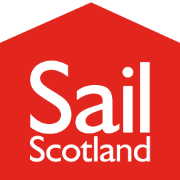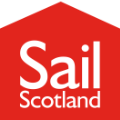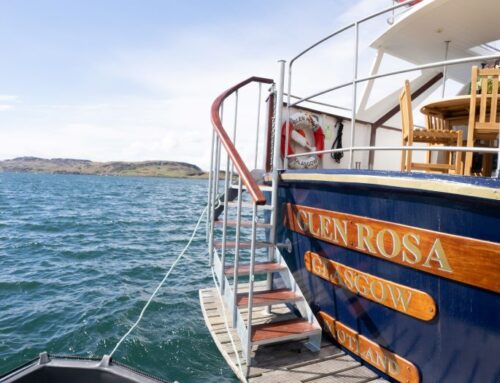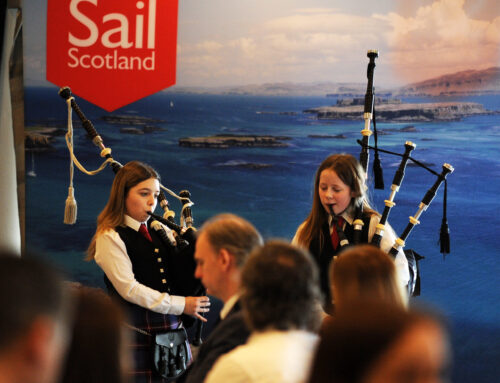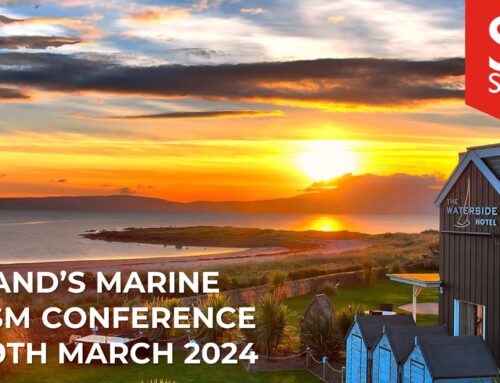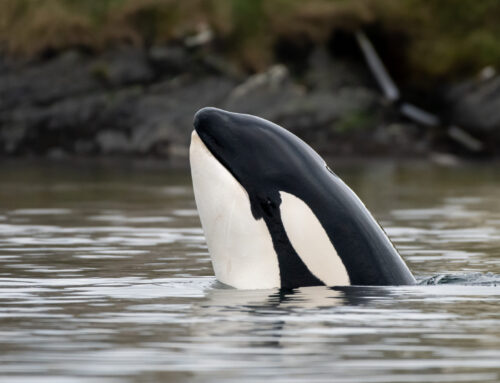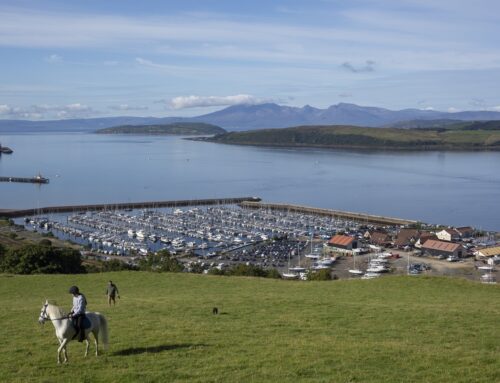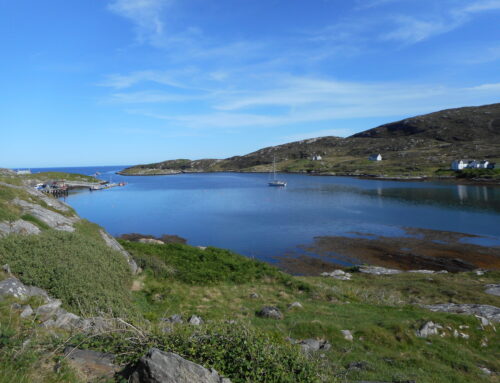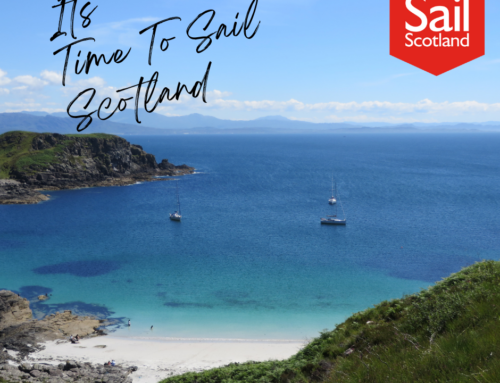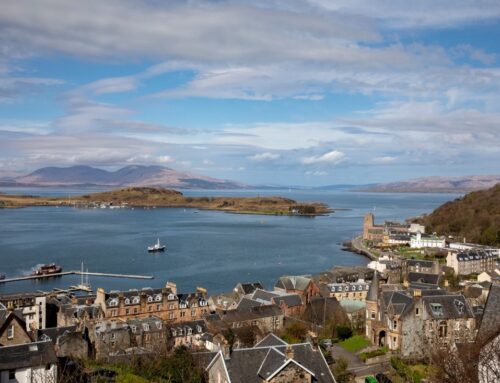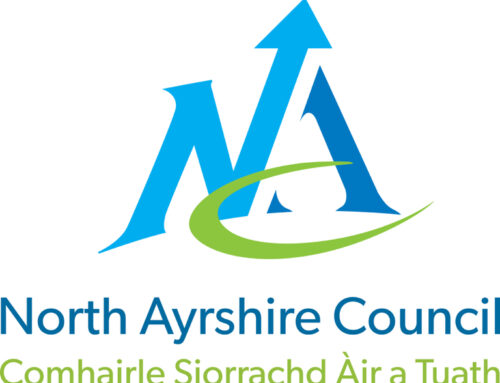Last year a number of Moonshadow’s regular guests expressed an interest in sailing to Orkney. So as part of this year’s programme, we planned a “circumnavigation of the Highlands” to incorporate the Orkney Islands.
Our guests arrived at Kyle of Lochalsh on the mid day train from Inverness for a 10 day cruise exploring the north-west highlands and along the north coast to Orkney onboard our Oyster 68.
The transiting pontoon at Kyle has recently been taken into community ownership and extended to provide extra berthing. This offers cruising yachts a good staging post to top up on food, fuel and water, with the bonus of a railhead for easier crew changes.
On this trip, Rosie & Charlie, Denise & Peter, Pat & John and Stuart were all “frequent flyers”. With everyone unpacked and settled in, a general plan for the cruise of where to go and what to see was discussed over a cup of tea and shortbread. We then ran through the usual safety briefing of the do’s and don’ts for life on board and what to do in the case of emergencies such as fire, flooding or falling in the water.
Slipping our lines, we squeezed Moonshadow’s mast under the elegant Skye Bridge with a couple of feet to spare and set sail, reaching up the Inner Sound to Acarsaid Mhor on the island of Rona.
Next day, under a mixed sky, we ran northwards under an obliging southerly breeze. Rounding the headland at Rubha Reidh, we altered course for the Summer Isles, a small group of islands to the north west of Ullapool. During the early 1940’s Frank Fraser Darling, often regarded as the father of the nature conservancy movement in Scotland, lived and farmed on the largest island of Tanera Mor by reclaiming derelict land for agricultural production. Nowadays the island is home to an Atlantic salmon fish farm, some rental holiday homes, a café and a post office which has operated its own local post and printed its own stamps since 1970.
Having pulled a couple of pollock from the bay earlier in the day, Charlie baited and laid our two creels before we entered the enclosed anchorage of neighbouring Tanera Beg for the evening.
The next morning we rose to a glorious sunrise and a mirror smooth sea, but the hauling of the creels revealed a disappointing catch of assorted of small velvet crabs and a couple of starfish – nothing for Pauline to work with in the galley – maybe next time!
We continued north, under engine until a gentle breeze filled in and, with sails unfurled, we rounded Rubha Coigeach and tacked over towards the unmistakable sugar-loaf mountain of Suilven and into the delightful fishing port of Lochinver. This highland harbour now benefits from a substantial breakwater that shelters the recently installed pontoons, providing a safe haven for small craft. A short walk ashore took us to the renowned Lochinver Larder – famous for their fabulous pies!
Moving onwards, into the late afternoon sun, we picked our way through a maze of rocks and reefs to the intriguing anchorage of Ob Coramach in the upper reaches of Loch Roe for a peaceful evening.
Another day and a change of weather saw us beating northwards past Point of Stoer under grey skies to anchor off a mist-shrouded Handa Island. Managed by the Scottish Wildlife Trust, Handa Island is internationally famous for its sea-bird colonies, including the largest breeding colony of guillemots in Britain. There are also puffin, fulmar, shag, razorbill, arctic and great skuas, kittiwake, gulls and terns. The magnificent Torridonian Sandstone cliffs, which rise to a height of 400 feet along the dramatic northern edge of the island have weathered over thousands of years to form horizontal ledges that are ideal for breeding seabirds. Each summer these cliffs come alive when over 100,000 seabirds gather here to breed.
After an afternoon exploring the island, we moved round into the tranquil waters of Loch Laxford and dropped anchor near John Ridgway’s Adventure School, now being run by his daughter Rebecca (www.ridgway-adventure.co.uk).
After dinner the charts were laid out on the saloon table and we all mulled over the latest weather forecast and discussed the passage plan for rounding the formidable Cape Wrath.
An early start the next morning brought clearing skies and lighter winds. Passing the impressive sands of Sandwood Bay we motored on past imposing cliffs to round the Cape without any wrath. We toasted this landmark in our cruise and gave Neptune a “thank you” dram.
Taking advantage of this settled spell of weather, we opted for a lunch-stop at the beautiful Balnakeil Bay, lying just a few miles to the east of Cape Wrath. Denise, Rosie and Charlie went ashore for a walk along the expanse of beautiful white sands and Rosie even succumbed to the temptation of a swim in the North Atlantic – respect!
But as often happens in this part of the world, a cheeky little weather front moved in and before we knew it we were beating into a stiff southerly as we entered Loch Eriboll for a safe anchorage.
Our next leg of the voyage required the working of the tides along the north coast in order to take advantage of the impressive currents in the Pentland Firth as we approached Orkney. In other words, a very early start!
The island of Hoy was soon upon us and, with the tidal stream topping ten knots, we took a sharp left turn, entering Scapa Flow through its southern entrance and anchored in the sheltered waters off the village of Longhope.
After lunch on deck, we decided upon an “excursion” – a taxi ride along the coast to visit the Scapa Flow Centre and Museum at Lyness, which tells the story of Britain’s wartime naval base.
The following day we sailed an anti-clockwise circuit of Scapa Flow that encompassed almost every aspect of Orkney’s recent history; from the Flotta Oil Terminal to the sunken Block Ships by the Churchill Barriers; the Italian Chapel built by POWs; past Scapa Distillery to the wreck of the Royal Oak where 834 lives were lost; the scuttling of Germany’s fleet of 74 warships during the Great War, and on to the picturesque port of Stromness.
Both of Orkney’s two main towns now have new fully appointed marinas, operated by the friendliest staff you could wish for, allowing visiting yachts the security and time to explore ashore. With its historic winding streets, dramatic aspect and busy harbour, Stromness is a town that has been shaped by seafaring, whaling and the herring over its 400 year history.
Carrying the next day’s tide out through Hoy Sound, we briefly turned south to photograph the Old Man of Hoy, one of the tallest sea stacks in Britain, before heading north past the wreck of the Hampshire and Lord Kitchener Memorial at Marwick Head, towards Eynhallow Sound. With strong winds now being forecast, we decided to tie up in Kirkwall Marina a day earlier than planned and explore the island’s rich archaeological past by bus.
Orkney has a fascinating history stretching back 6,000 years, but to visit its Neolithic sites such as Ness of Brodgar, Skara Brae and Maeshowe you do need to travel inland and there are a number of businesses in Kirkwall that provide such tours.
Kirkwall itself is a vibrant town. With its harbour and airport, it is the arrival point for ferries from Shetland and Aberdeen, and flights from the UK. It is also the best place to stock up on supplies before heading on. Kirkwall’s most striking feature is perhaps its sandstone St Magnus Cathedral, widely considered the finest medieval building in the north of Scotland and the original town is one of the best preserved examples of an ancient Norse town.
Then, all too swiftly, it was time for farewells and for our guests to catch their flights south.
The following day Moonshadow headed out east through “The String” before turning south, past the Pentland Skerries and Duncansby Head, towards Inverness and the Caledonian Canal, ready to receive our next guests and complete our circumnavigation of the Highlands.
By Colin Taylor
Moonshadow Yacht Charter Ltd
